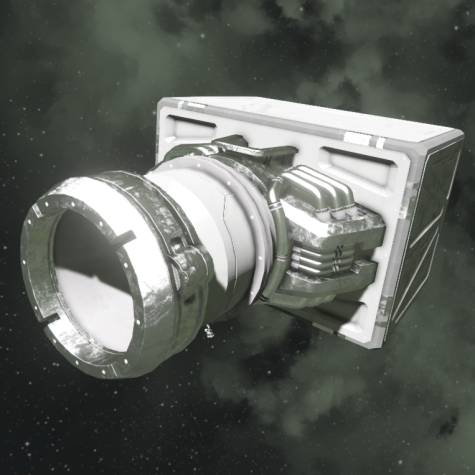Large Ion Thruster


Thruster block information is listed in the table down below.
| Components | Required |
| Steel Plate | 50 |
| Construction Component | 30 |
| Functional | |
| Thruster Components | 960 |
| Large Steel Tube | 40 |
| Construction Component | 70 |
| Steel Plate | 100 |
| Info | |
| Dimensions (W,H,L) | 3,2,4 |
| Mass | 43,200 kg |
| Integrity | 49,200 |
| Build Time | 90 s |
| Max Power Consumption | 33.6 MW |
| Min Power Consumption | 2 W |
| Force | 4,320 kN |
| Effectiveness at max influence | 20 % |
| Effectiveness at min influence | 100 % |
| Max planetary influence | 100 % |
| Min planetary influence | 0 % |
| Max Flame Length | 11.897 m |
| Power Consumer Group | Thrust |
| Is Airtight | Partially |
| PCU Cost | 15 |
| Components | Required |
| Steel Plate | 4 |
| Construction Component | 1 |
| Functional | |
| Thruster Components | 12 |
| Large Steel Tube | 5 |
| Construction Component | 1 |
| Steel Plate | 1 |
| Info | |
| Dimensions (W,H,L) | 3,2,4 |
| Mass | 721 kg |
| Integrity | 1,220 |
| Build Time | 20 s |
| Max Power Consumption | 2.4 MW |
| Min Power Consumption | 2 W |
| Force | 172.8 kN |
| Effectiveness at max influence | 20 % |
| Effectiveness at min influence | 100 % |
| Max planetary influence | 100 % |
| Min planetary influence | 0 % |
| Max Flame Length | 1.978 m |
| Power Consumer Group | Thrust |
| Is Airtight | Partially |
| PCU Cost | 15 |
Overview
This block is a larger variant of the Small Thruster, otherwise known as the “Ion Thruster“. It moves a ship (grid) in the opposite direction of the exhaust point. The Large Thruster provides large amounts of thrust. One of these is the rough equivalent (in thrust but not in energy consumption) of 12 Small Thrusters. A large thruster occupies a half the surface area of the equivalent amount of small thrusters (2×3) blocks, versus 12x(1×1) blocks for 12 small thrusters. Large thrusters are also more cost efficient, costing less iron, and producing more thrust per MW than their small thruster counterpart. These properties make the large thruster a viable upgrade from an array of small thrusters.
One disadvantage compared to small thrusters is that it is considerably longer (especially when accounting for the thruster damage zone). However, this is rarely a real problem as thrusters are generally pointed outside the ship, towards space (hence, that dimension was ignored in the above size comparison).
As of patch 01.022, Large Thrusters will damage anything behind them for up to 7 blocks in a cross pattern. If the space directly behind the thruster is clear, then the blocks on the side will not take damage.
- For more information on all thrusters and their mechanics, see Thruster.
Usage
Ion Thrusters are used to move a ship (grid) in a specific direction, and also used to stabilize it’s position with inertial dampeners. In order for a grid to be entirely stable, thrusters must be placed in the front, back, left, right, top, and bottom positions.
Large Thrusters don’t require any type of fuel other than energy sources such as a Large Reactor in order to function. They can run on any amount of power, however their full potential can only be used with larger amounts of power.
Tips
- If your ship is completely still in space, your thrusters will remain in standby mode and only will draw bare minimal amounts of power.
Programming
Thruster (Ion, Hydrogen, Atmospheric)
Interface name: IMyThrust
Parent: IMyFunctionalBlock
Fields:
float Override
Actions:
OnOff -> Toggle block On/Off
OnOff_On -> Toggle block On
OnOff_Off -> Toggle block Off
IncreaseOverride -> Increase thrust override
DecreaseOverride -> Decrease thrust override
